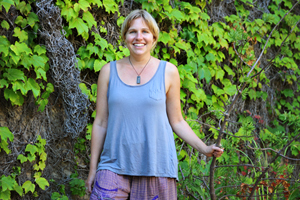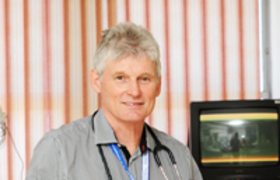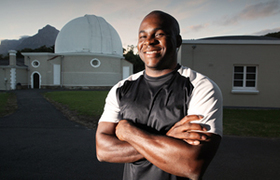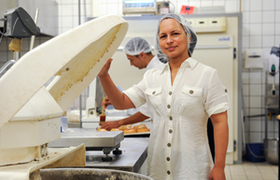Saving the Renosterveld, one hectare at a time
17 February 2014
The deep tan tells the story.
For Dr Odette Curtis, working 'in the field' means just that - actually applying sunblock and toiling in the sun.
The conservationist and botanist, who graduated with a doctorate from UCT in 2013, has made her home in Napier in the Overberg, about two hours outside Cape Town, where she puts in the hard yards to preserve the delicate Renosterveld ecosystem.
Renosterveld - literally translated from Afrikaans as 'rhinoceros field' - is a term used to describe one of the major and most diverse plant communities and vegetation types of the Cape Floral Kingdom. Human activities such as farming have decimated these fertile fynbos havens, and Curtis is hard at work trying to preserve the critically endangered survivors.
"It's estimated that there's less than between four and six percent of the Renosterveld left," says Curtis. Even this is an optimistic estimate; the true figure could be significantly lower, she says.
Such is the diversity of the Renosterveld that Curtis discovered six new species of plants in 2012, and two were named after her. Not a bad compromise for someone who wanted to be a game ranger while growing up.
Instead of the game ranger route, Curtis pursued a BTech in Nature Conservation (UCT didn't offer the specialised programme she sought at undergraduate level) and an MSc in Zoology from UCT. Her master's research focused on how two raptors - the black harrier and black sparrow hawk - responded to the fragmentation of their habitats, both individually and as a population.
When an opportunity arose to do a PhD in the United States on birds of prey, Curtis decided against it, being reluctant to be limited to specialised raptor research.
"I was more interested in general ecology than just focusing on one or two bird species," she says. "My research into black harriers had taken me into the Overberg, where I spent a lot of time looking for black harriers in the Renosterveld.
"Being out in the veld, being out in the Renosterveld and seeing how many farmers were not correctly managing [the environment] from a grazing and fire perspective, I got back to what I was really interested in: veld management. That got me into the plants and away from the birds, and to thinking more about saving their habitats.
"So [I got into] saving the habitats of lots of things, not just plants or one or two birds."
Curtis' CV is enviable. In addition to her degrees, she has co-authored eight scientific papers; managed UCT's Black Harrier and Black Sparrowhawk Projects from 2000 through to 2006; was invited as a Leadership Intern to Hawks Mountain Sanctuary, Pennsylvania, USA, for two months in 2005; and was contracted by CapeNature's Stewardship Programme from 2007 to 2011.
She has also been a board member of the Fynbos Forum since 2009 and served as a committee member of the Botanical Society, southern Overberg branch, from 2009 to 2011.
Curtis now directs the Overberg Lowlands Conservation Trust, whose vision is to work with local farmers to secure the long-term conservation and management of the remaining fragments of threatened natural vegetation in the lowlands of the Overberg.
It's a tough ask getting farmers to change decades-old habits, but Curtis's eyes light up when she speaks about their successes. Little by little, farmer by farmer, she and her colleagues are changing mindsets and ensuring the survival of the region's fynbos.
Much of the farmers' thinking revolved around the frequency that the veld needed to be burned. Curtis's doctoral research explored how often the veld needed to burn, whether it needed to burn at all, and how best to manage grazing in the region.
The results were surprising.
"We found that Renosterveld does respond favourably to fire; which is known, but not really written up properly," she says. "What was concluded was that Renosterveld shouldn't burn as frequently as was believed. Previously, ecologists have advised burning it every three years. I concluded differently - it should be more like fynbos-burning, which is between eight and 15 years.
"So, 10 would be the average. The reason for that is just to use a precautionary approach, and because there are also some slower-maturing plants that probably need time to develop properly. If you burn it a lot, you'll turn it into grassland."
Which leads to "probably the biggest chapter" of Curtis's thesis: debating whether the Renosterveld was a grassy shrub land or shrubby grassland.
"It probably sounds very arbitrary, but it affects how you manage it. If you're managing it as grassland, you're burning every two or three years. If you're managing it like shrub land, you're treating it like fynbos."
While some of the farmers have come on board with her recommendations - in fact, the chairperson of the Overberg Lowlands Conservation Trust is a farmer - Curtis is prepared for more hard slog.
"It's a long road that we have to travel to change mindsets on a scale that means we can actually change things. There are not enough people alerting farmers to the beauty on their lands, and these are the same farmers who will pay thousands of rands to sit in a game reserve."
Her passion for her cause is easy to see, and she admits that her work comes at a price.
"It's emotionally draining. It's exhausting. It's too close to my heart. I can't separate my work from my feelings. When I see something go wrong, when I see a piece of land being ploughed or something terrible happening, I can't deal with it."
Don't expect Curtis to be discouraged, though.
Story by Yusuf Omar. Image by Raymond Botha.
 This work is licensed under a Creative Commons Attribution-NoDerivatives 4.0 International License.
This work is licensed under a Creative Commons Attribution-NoDerivatives 4.0 International License.
Please view the republishing articles page for more information.










